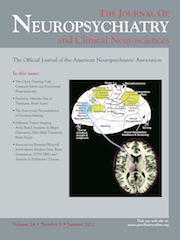Decreased Expression of CCL3 in Monocytes and CCR5 in Lymphocytes From Frontotemporal Dementia as Compared With Alzheimer’s Disease Patients
To the Editor: Inflammation has an important role in neurodegenerative process. Cytokines and their receptors are expressed physiologically in the central nervous system (CNS) and immune cells and are important for development and function of the brain. There is considerable evidence to suggest that an inflammatory response may be involved in the Alzheimer’s disease (AD) neurodegenerative cascade and in other dementias, as well.1 Most studies that aimed to investigate the role of the immune system in dementia patients were performed on cerebrospinal fluid (CSF). Although CSF has strong contact with CNS cells, its collection is an invasive procedure.
Very little was studied about immunological aspects involved in the neurodegenerative process in Frontotemporal Dementia (FTD) patients, as compared with AD. Although AD is mostly associated with innate immune responses within the brain, triggered by accumulating cerebral Aβ; there are some studies showing the importance of T-cells in this condition.2
The existing clinical criteria for the diagnosis of FTD and associated syndromes have limitations; as a result, clinical dementia diagnoses are not always consistent with postmortem neuropathological findings.3 Because a correct diagnosis is important for care and to avoid inadequate treatment, new diagnostic tools, with higher sensitivity and specificity, are in demand. In this context, there is a growing interest in developing biomarkers for dementia. In clinical practice, FTD is commonly misdiagnosed as AD.4
There is much work evidencing the enhanced peripheral expression of the chemokine CCL3 (MIP-1α) and also its chemokine receptor, CCR5, from AD patients. However, no study showing its expression in peripheral cells from FTD patients has been reported. Therefore, our aim was to investigate the chemokine and its receptor expression in the peripheral cells of FTD patients and compare with AD patients’ cells. We found a decreased expression of CCL3 in the monocytes CD14+ from FTD patients (5.86 [2.88]), as compared with AD patients (14.4 [21.10]; p=0.04; Figure 1). In a similar way, we observed a decreased CCR5 expression in CD4+ T-lymphocytes from FTD patients (0.57 [0.66]), as compared with AD patients (2.40 [1.30]; p=0.02) (Figure 1). Sample size for the AD group was 48 (16 men/32 women) and, for FTD, 12 (5 men/7 women). The mean age of AD patients was 81.09 (6.60) and, for FTD, was 72.0 (12.5); mean (SD) MMSE score in AD was 13.35 (3.75) and in FTD was 16.8 (6.9).

FTD: frontotemporal dementia; AD: Alzheimer’s disease.
Peripheral blood monuclear cells (PBMC) were cultured for 18 hours and stained with mAbs anti-CD14 FITC, anti-CD4Cy7, and anti-CCL3PE or anti-CCR5PE and evaluated by flow cytometry. AD: N=48 patients; FTD: N=12. Mann-Whitney tests were used, and significance was set at <0.05.
Discussion
It is speculated that the higher expression of CCL3 and CCR5 in peripheral cells and its transmigration through the CNS parenchyma in AD might be important.5,6 Our work decisively showed a reduced CCL3 and CCR5 expression in lymphocytes and monocytes of FTD patients, as compared with AD patients. This might reflect the different participation of immune cells in the pathophysiology of dementias and suggest this chemokine and chemokine receptor expression in peripheral cells as putative biomarkers for differential diagnosis between FTD and AD.
Grant support: Coordenação de Aperfeiçoamento de Pessoal de Nível Superior (Capes), Conselho Nacional de Desenvolvimento Científico e Tecnológico (CNPq) and Fundação de Apoio a Pesquisa de Minas Gerais (FAPEMIG).
1 : Inflammation in Alzheimer disease: driving force, bystander or beneficial response? Nat Med 2006; 12:1005–1015Medline, Google Scholar
2 : Biomarkers of inflammation and amyloid-beta phagocytosis in patients at risk of Alzheimer disease. Exp Gerontol 2010; 45:57–63Crossref, Medline, Google Scholar
3 . Clinicopathological concordance in dementia diagnostics.Google Scholar
4 : Clinicopathological concordance in dementia diagnostics. Am J Geriatr Psychiatry 2009; 17:664–670Crossref, Medline, Google Scholar
5 : Semantic dementia: demography, familial factors and survival in a consecutive series of 100 cases. Brain 2010; 133:300–306Crossref, Medline, Google Scholar
6 : Peripheral T-cells overexpress MIP-1alpha to enhance its transendothelial migration in Alzheimer’s disease. Neurobiol Aging 2007; 28:485–496Crossref, Medline, Google Scholar



